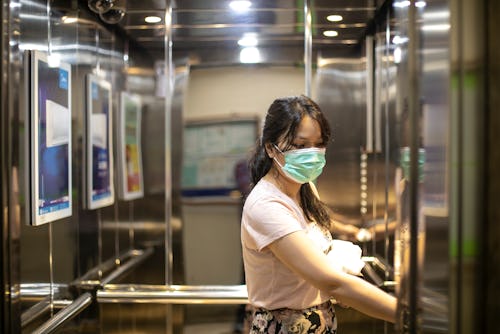Health
A Doctor Explains How You Can Protect Yourself From COVID Inside An Elevator
The risk doesn't necessarily start once you walk into an elevator.

Though some businesses are opening up again and states around the nations are slowly lifting lockdowns, the number of coronavirus cases in the U.S. are still rising. This has lead many people to reassess the way they use everyday things. From public restrooms to hotels, everything that was once used haphazardly now requires extreme care and caution. Even the most seemingly harmless activities could lead to exposure to COVID-19 if you're not sure to be careful — even taking the elevator.
In early July, the Center for Disease Control and Prevention (CDC) conducted a study on an asymptomatic traveler who seemed to have given coronavirus to other people in her building without ever crossing paths with them. The CDC found that though she never used the elevator at the same time as anyone else, the virus still spread through surfaces she touched.
But don't panic — there are ways to safely use an elevator during the coronavirus pandemic.
Dr. Jen Caudle, DO, Family Physician and associate professor at Rowan University, tells Bustle that the risk of using an elevator depends on where you are. Elevators in places that have a higher number of coronavirus cases than others are more likely to be risky. "Depending on how you use your elevator, if it's crowded or you're not wearing masks or not using safety precautions... that's going to put you at greater risk as well," Dr. Caudle says. "So the level of transition and the community I think would affect the risk level, as well as your personal practices."
But she says that while there are risks, it's important to know that we can reduce these risks. "Getting on a crowded elevator are certainly more risky than being in an elevator with fewer people or no people, so I would opt to get on the elevator when no one else is on it, or maybe just one other person and avoiding elevators with lots of people," she says. She also stresses wearing a mask at all times and keeping as much distance from other people in the elevator as possible. Avoiding pressing buttons, washing your hands after pressing a button if necessary, or only using your elbows to press buttons are good practices, too.
Dr. Caudle also brings up the point that the risk doesn't necessarily only start once you get into the elevator. Oftentimes, there will be waiting areas or lobbies in front of elevators where many people might be in one place. Practicing social distancing and wearing a mask even when you're outside of the elevator can also reduce risk of coronavirus transmission.
But if you're still super nervous about being in an enclosed space with a bunch of strangers with rising COVID-19 cases — that's totally understandable. Dr. Caudle says that taking the stairs can be much less risky than taking elevators. "Stairs also has the added benefit of giving you exercise," she says. "So that's always a good thing."